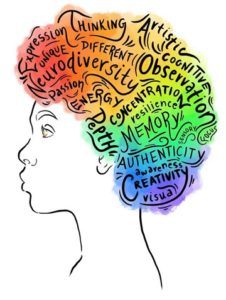Diversity and Disability in the Workplace
Just like trees in a forest, people are unique. Some have red hair, some have black hair and some are blond. Some are tall, others are small. There is diversity everywhere.
These features are visible. But other features such as neurodiversity and some physical disabilities are invisible. Is your business set up to accommodate these invisible differences?
What is Neurodiversity?
Neurodiversity is a concept that was established in the late 90s. The idea is that differences in the way our brains function are normal, rather than a problem. In the same way that some of us are tall or short, neurodiversity means each of our brains are wired in a slightly different way. Because of this, neurodiversity is something we should respect, not fear or belittle.
Examples of these differences include:
- Attention Deficit disorder/hyperactivity disorder (ADHD)
- Autism
- Schizophrenia
- Dyslexia
- Dyspraxia
- Dyscalculia
- Asperger’s
- Obsessional compulsive disorder (OCD)

What is a Disability?
A disability is recognised under the Equality Act 2010 as a physical or mental impairment that has a substantial or long-term negative effect on a person’s ability to do normal daily living activities. ‘Substantial’ is classified as more than minor or trivial eg it takes much longer that it usually would to complete a daily task like getting dressed, while ‘long term’ means 12 months or more – such as a breathing condition that develops as a result of a lung infection.
It’s important to understand that although neurodiversity can be a disability for some people, the idea behind the term ‘neurodiversity’ is that it is simply a variation in the human brain. It should never be assumed that just because someone is neurodivergent that they are disabled.
How common is neurodiversity and disability?
Neurodiversity and disability are more common than many people realise.
It is estimated that 15% of the population are classified as neurodivergent, while 20% of the working age population were reported as being disabled in 2020. These disabilities can include hidden disabilities such as epilepsy or hearing loss.
Where are their conditions first recognised?
While physical disability is often easier to identify and diagnose, neurodivergent people may go for many years before being recognised as such. They may display behavioural issues such as being unsociable, withdrawn, clumsy or angry with temper tantrums. People may make spelling errors, be slow readers or poor at maths.
If not investigated, these issues can lead the person to believe that they are stupid or a ‘bad’ person. This is often reinforced with scolding from teachers, poor exam results and comparison to others.
School
Increasing numbers of children are being recognised as neurodivergent as understanding of the range of differences improves. Although some unfairly dismiss this as ‘finding excuses for poor behaviour’, by identifying a child’s difference and then supporting them and their family, these children can receive a quality education and go on to thrive as adults.
At college or university
Many colleges and universities are well-resourced in helping students with known disabilities or neurodiversity, or those who are showing signs of being neurodiverse. This story is an excellent example. Students may find themselves diagnosed with a condition which goes on to impact their life substantially. Multiple Sclerosis is an example of a condition that is often diagnosed in people in their twenties.
At work
Many people are not recognised as neurodiverse until much later in life, perhaps as late as in their 50s. It might only be when an event at work is investigated or when an employee fails to perform as expected that the possibility of their difference is investigated. Adults with a late diagnosis often talk about how things ‘finally make sense’.
Some employees may develop physical disabilities, sometimes in relation to conditions that have previously not been a problem. Poor eyesight, diabetes, even menopause symptoms can become disruptive enough to be classified as a disability.
Sometimes a sudden medical condition or accident will mean a person will be disabled for the rest of their life as this example shows:
A healthy and fit lawyer aged 29 woke up one morning, unable to get out of bed. She had had a spinal stroke. Despite thinking this was a temporary situation, it soon became clear she would need to spend the rest of her life in a wheelchair. Her employer gave her a role as Chairman of a team to help clients who had people who were Diverse or had Disabilities. Her own problem then became her expertise. She is now a national figure on Disabilities in the workplace in the UK.
How can employers better accommodate disabled and neurodiverse employees in the workplace?

Interview and selection
By being clear that you are an equal opportunities employer who supports employees regardless of their differences, you will encourage people to mention their neurodivergence or disability at interview. This then allows you to put measures in place to support them should they be suitable for the job.
Onboarding
After the job offer and prior to starting, discuss job tasks with the new employee so that you can make adjustments to help them perform to the best of their ability. These adjustments don’t need to be complex as this example shows:
A deaf employee who lipreads at all times was unable to do so due to the need to wear masks to protect against COVID. He worked on a building site. His employer made a variety of adjustments, including a high visibility jacket with the message ‘hard of hearing’ on the front and back of the jacket. These simple changes meant he was able to continue to do his job, resulting in a happy man and an employer who was able to keep an experienced and valuable member of staff.
Day to day support
There are several ways businesses can support employees with their differences. Here are four of the most important:
- Occupational Health Support
Businesses can use occupational health services to support neurodiverse or disabled employees. More than this, occupational health can help confirm the nature of the employee’s difference and identify what adjustments are required in their work activities.
- Line Managers
As the employee’s main support within the business, it is important for line managers to improve their understanding of how to support and work with their employee. Not only will this support the relationship between the line manager and direct report, but it will also strengthen that manager’s people management skills as they advance their career. This can be an important step in improving your organisation’s performance in diversity and inclusiveness.
- The IT department
Many software packages are available to help neurodivergent and disabled employees such as:
- Text to speech
- Mind mapping
- Information capture tools
- Speech to text.
Your IT department has access to a wide range of technology-based solutions and can become an important partner in ensuring inclusivity.
4. Business leadership
Ultimately, an organisation’s sets their culture and attitude towards inclusivity at the very highest level. Reassurance by management that neurodivergent and disabled employees are welcome and appreciated is important along with open discussion about the value of a diverse workforce.
The great thing is to focus on a person’s strengths and to explore and accommodate their difference at all times.

However, it’s crucial to remember that we are all different. Successfully dealing with one person’s diversity issue does not mean it understands and is inclusive in addressing all needs. Inclusivity is very much an ongoing effort; to make sure you accommodate everyone regardless of their difference, you should continue to work closely with your employees, being sure to ask, listen and understand their perspective. Only then can you take steps to ensure inclusivity.
Where does your business stand on matters relating to neurodiversity and disability?
Do you have a policy and systems in place?
- We recently supported an employee with a problem related to their neurodiversity – a reactive approach.
- We have a policy and systems in place for all in your business to understand – a proactive approach.
If you are looking for top-quality gaming experiences and valuable articles, that are useful for players, then we have a great recommendation for you – explore Slotogate, a gaming platform from our trusted sponsor. From classic blackjack to modern table games variations as well as various slots, they offer a wide range of exciting options. Plus, enjoy exclusive bonuses and reviews for the safest casinos like lion slots casino review. Discover the joy of Slotogate with a visit that promises a delightful experience!
